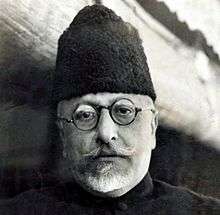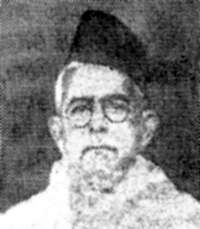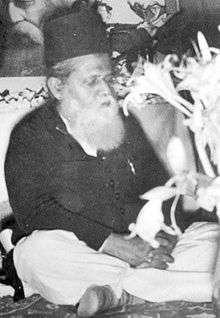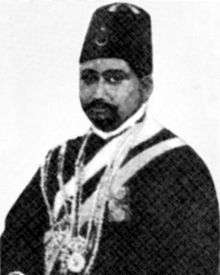Anjuman-i-Ulama-i-Bangala
Anjuman-i-Ulama-i-Bangala (Bengali: আঞ্জুমান-ই-উলামা-ই-বাঙ্গালা Assembly of the Scholars of Bengal), was an association of Muslim religious leaders in British India's Bengal Presidency.[1] It later formed a branch of the Jamiat Ulema-e-Hind by the name Jamiat Ulema-e-Bangala in 1921.
আঞ্জুমান-ই-উলামা-ই-বাঙ্গালা | |
| Abbreviation | AUB (আউবা) |
|---|---|
| Named after | Ulama of Bengal |
| Merged into | Jamiat Ulema-e-Hind |
| Formation | 1913 |
| Founder | Abul Kalam Azad, Maniruzzaman Islamabadi, Mohammad Akram Khan, Muhammad Abdullahil Baqi, Muhammad Shahidullah |
| Founded at | Calcutta, Bogra |
| Extinction | 1921 |
| Type | Islamic |
| Legal status | Religious organisation |
| Origins | Islam in Bengal |
Region | Bengal |
Official language | Bengali, Arabic |
| Islam in Bangladesh |
|---|
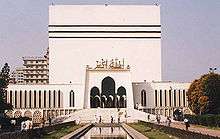 Baitul Mukarram, the National Mosque of Bangladesh in Dhaka, was built in 1962 and resembles the Kaaba |
| History |
|
| Architecture |
|
| Major figures |
| Culture and literature |
| Communities |
|
| Religious jurisprudence |
| Ideology/schools of thought |
| Mosques |
|
| Politics |
|
| Educational organizations and institutions |
|
| Influential bodies |
History
The association was established in March 1913 at a conference in Beniapara, Bogra by some of Bengal's most senior scholars such as Abul Kalam Azad, Muhammad Abdullahil Baqi and Muhammad Shahidullah.[2] The first president and secretary of the Anjuman was Mohammad Akram Khan with Maniruzzaman Islamabadi as joint secretary.[3] Ismail Hossain Siraji was also a notable member of the organisation.[4] Aiming to bring about Muslim unity, regardless of sects, and prevent Muslims from converting to Christianity.[5]
On 3 May 1915, the association initiated an illustrated monthly Bengali publication known as Al-Eslam, with Akram as chief editor.[2] Notable writers for the paper included Begum Rokeya and Fazlul Hoque Selbarsi. Over 1500 copies were in circulation. It contained articles on history, literature, philosophy, and cultural heritage.[6]
Two years later, they hosted their second conference in Calcutta. The third conference took place in Patiya in August 1919. Promoting Hindu–Muslim unity, the organisation actively participated in anti-colonial uprisings such as the Khilafat Movement as well as Gandhi's Non-cooperation movement. They opened a Swadeshi-Khilafat store in Calcutta, promoting the sale of native goods. The uprisings changed the socio-politics in India and the association was eventually disbanded in 1921 to merge with the Jamiat Ulema-e-Bangala, a regional branch of the Jamiat Ulema-e-Hind.[2]
Aims
Its aims included providing Islamic education, countering hostility and misconceptions preached by Christian missionaries as well as reforming and uniting Muslim society to an orthodox fashion through the Quran and Sunnah.[7] This included actively educating unlettered and illiterate Muslims of Bengal and Assam about shirk and bidʻah. At the same time, the organisation promoted Hindu–Muslim unity. Many maktabs, madrasas, bayt al-mal and social arbitration boards were founded and funded by the organisation; bringing about solidarity and a strong morale amongst Muslims. They popularised the use of the Bengali language amongst the Muslim middle-class.[8] There was also an aspiration of establishing an Islamic university in Chittagong although this never came into being.[7]
Members
See also
- Faraizi Movement
- Muharram Rebellion
- Titumir
References
- Amin, S N (1996). The World of Muslim Women in Colonial Bengal, 1876-1939. BRILL. p. 119. ISBN 9004106421. Retrieved 8 March 2015.
- Samaddar, Ranabir. Emergence of the Political Subject. India: SAGE Publications Ltd. pp. 85–96.
- Chatterjee, Srilata (2003). Congress Politics in Bengal 1919-1939. Anthem Press. pp. 46, 111.
- Anwarul Karim (15 Sep 2018). "Syed Ismail Hossain Siraji: A Tribute". The Daily Star (Bangladesh).
- Dr Rafiuddin Ahmed (2001). Understanding the Bengal Muslims: Interpretative Essays. Oxford University Press. p. 96.
- Sarkar, Chandiprasad (1991). The Bengali Muslims: A Study in Their Politicization, 1912-1929. K.P. Bagchi & Company. pp. 60–199.
- Dev, Sunil Kanti (2012). "Anjuman-i-Ulama-i-Bangala". In Islam, Sirajul; Miah, Sajahan; Khanam, Mahfuza; Ahmed, Sabbir (eds.). Banglapedia: the National Encyclopedia of Bangladesh (Online ed.). Dhaka, Bangladesh: Banglapedia Trust, Asiatic Society of Bangladesh. ISBN 984-32-0576-6. OCLC 52727562. Retrieved 18 August 2020.
- Muhammad Inamul Hoque (2012). "Islamabadi, Maulana Maniruzzaman". In Islam, Sirajul; Miah, Sajahan; Khanam, Mahfuza; Ahmed, Sabbir (eds.). Banglapedia: the National Encyclopedia of Bangladesh (Online ed.). Dhaka, Bangladesh: Banglapedia Trust, Asiatic Society of Bangladesh. ISBN 984-32-0576-6. OCLC 52727562. Retrieved 18 August 2020.
